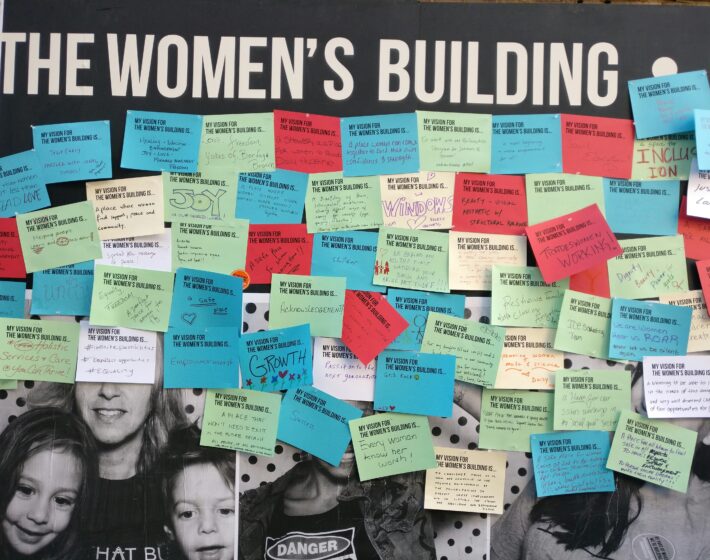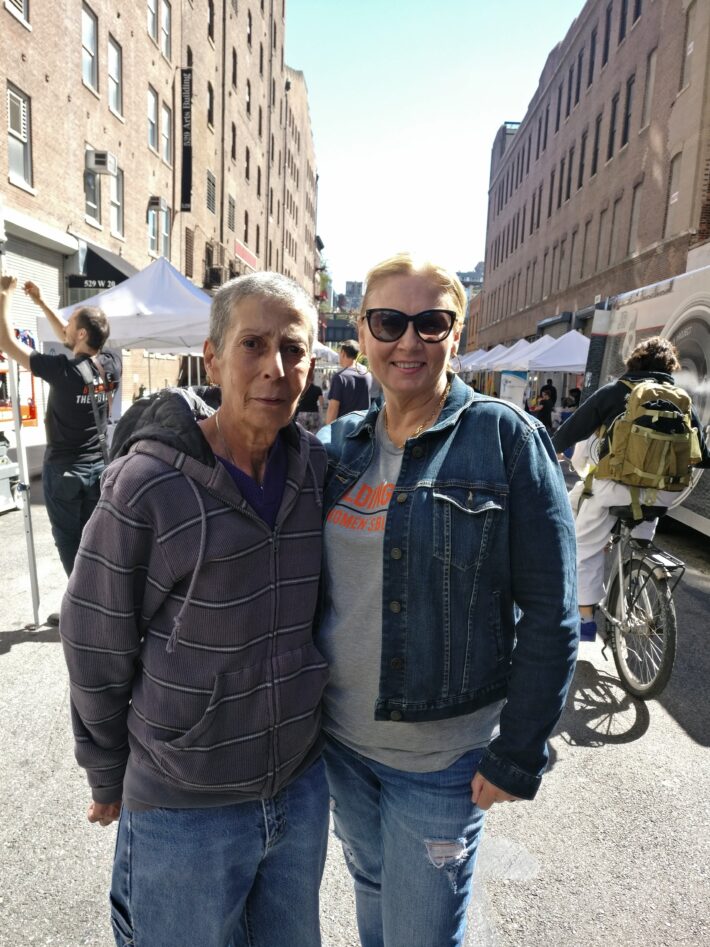
On a warm, windy Sunday morning in late September, a group of formerly incarcerated women paced up and down the block of 20th Street between Chelsea Piers and the High Line Park, getting ready to host a block party with The Women’s Building, a women’s advocacy project in Chelsea.
With a string of nearly 20 pop-up booths, an instant photo booth, a performance stage, a “vision” wall where people could share their ideas, this was the group’s first direct contact with the neighborhood before construction gets underway early next year.
The Women’s Building is going to redevelop the 85-year-old red brick structure on the south corner of the street to rent out office space for advocacy groups working with women and girls. It will also include a community space with a wellness clinic, public atrium and art galleries, day-care centers and other services to help women, especially those out of prison, find medical assistance, employment and housing.
Originally built as a Y.M.C.A for seamen, the building was transformed into Bayview Correctional Facility, a women’s medium security prison, in 1978. When Hurricane Sandy inundated the city in fall 2012, around 170 inmates were transferred to other state prisons, leaving the space empty.
NoVo Foundation, a private women’s advocacy group founded by Peter Buffett, son of investor Warren Buffet, and his wife, philanthropist Jennifer Buffett, has leased more than 100,000 square feet of the site, including the main building and an annex. The project, a partnership between NoVo Foundation and Goren Group, a female-led real-estate development group, is expected to be completed by 2020, with demolition expected to begin early next year.
“The idea behind the party is to raise awareness about the project, and get the community involved,” says Tatiana Eck, senior project manager of Goren Group. “The workforce for this project is entirely women.”
While the main building will undergo only internal renovations, the laundry facility annex to the east will be demolished so that a 16-story building can go up.
While the group has agreed to reduce the height of a portion of the new building in the Special West Chelsea District from 190 feet to 175 feet, it is still slightly higher than than the 150-foot cap suggested by community board 4. However, Betty MacIntosh, the co-chair of the board’s Chelsea land use committee, is positive about the impact of the project. “The Women’s Building has agreed to reduce the height of the structure and we support the concept and initiative put forward by the group. I think a group dedicated to work for the community is going to add to the character of Chelsea,” she said.
Alex Dupuy, who attended the party, has been living in Chelsea for about 40 years, and finds this project a relief from what he calls the “hot” redevelopments in the neighborhood. “I wouldn’t mind seeing a couple of extra floors being added for a cause that aims to give something back to the community,” he said.
As the afternoon performances began, an enthusiastic crowd cheered for a piece by Mightee Shero Productions, a theatre group advocating women’s rights. The group performed an excerpt from “Here To Be Seen,” the story of Stacey Hamilton, a formerly incarcerated women from Bedford Hill who was sexually abused by an officer. In 1993, Hamilton filed a complaint against her abuser and won the case, which resulted in legislation that prohibits any male officer from pat-frisking female inmates in state prisons.
She was released in 2007, having served 18 years for first degree manslaughter, double the time she was sentenced to. Hamilton, now an assistant deputy director at Fedcap Rehabilitation Services, a non-profit that helps people with disabilities find employment, was present at the event, and said that the building marks a historic moment for incarcerated women. “Nobody has ever thought about us, and we’re finally getting a voice,” she said.

Gloria Rubero, who served 26 years for sequential convictions for second-degree murder and robbery and was released in 2006, volunteered for NoVo at the party. Out of prison at 56, she struggled to find a job and a home. She worked for six years at New York Harm Reduction Educators, a non-profit helping young drug addicts and sex workers rebuild their lives, until the organization saw huge lay-off in 2013.
“Nobody is willing to employ you when you’re 50, and no one cares about the skills you learnt in prison,” she said. She said that a landlord would only agree to a lease if she agreed to pay a whole year’s rent in advance.
Currently unemployed, Rubero said that the women’s building will be a space for people like her to seek support, and escape the drudgery of odd jobs for incarcerated women her age.
Mary Johnson, another former inmate at Bayview who served 15 years for a drug conviction, said that the “collateral consequences” of being in prison made incarcerated women even more helpless. “This is how poverty pushes a lot of incarcerated women back into criminal activities. We’re never really offered a second chance,” she said.
Johnson is now a clinical director of the Coming Home Program at Center for Comprehensive Care at St. Lukes-Roosevelt Hospital Center, which addresses the mental, physical and emotional well-being of women just out of prison. She believes that the new building will make it easier for women like her to find medical support.
Anneke Lucas, who has brought healing yoga programs to inmates as the founder of Liberation Prison Yoga, feels that going into the prisons to rehabilitate women is critical to helping them once they are out. “The life of these women in prison can be extremely traumatic, and we do our best to touch their lives and make a difference while they’re in the prison. This building is a step towards the same,” she said. She hopes to have an office in the building once it is ready.
With more than 160 suggestions posted on the vision wall, what the NoVo Foundation estimated as “hundreds” of people crowded around the stalls all through the day, and stood in line at the photo booth past the 5 p.m. end of the event. Joe Voeller, the spokesperson for NoVo, said that the response to the event was heartening. “We’ve wanted this project to be a community initiative, and the overwhelming response from the neighborhood affirms our belief in what we’re doing,” he said.